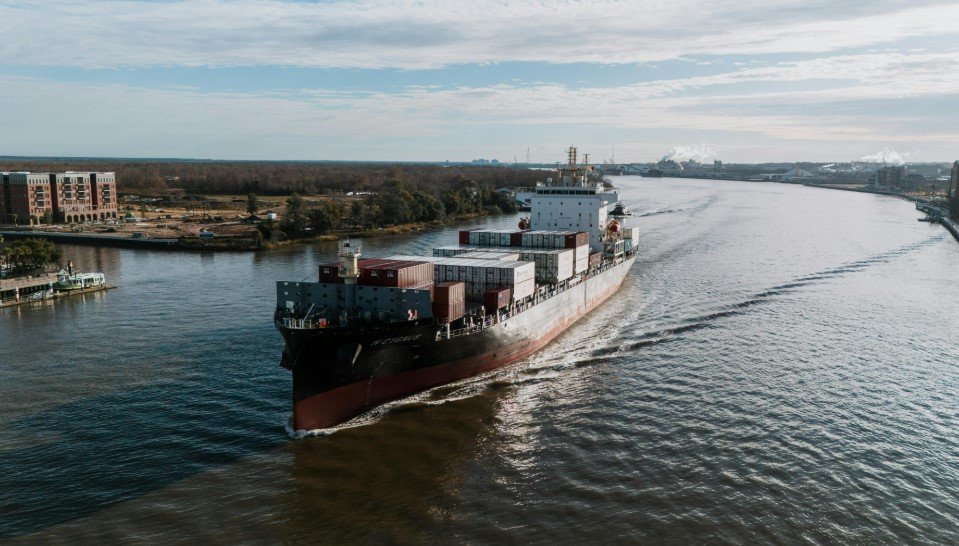Container traffic at Georgia’s ports surged again this year—even as tariff uncertainty rattled global trade. The state’s port authority logged its second-busiest fiscal year on record, defying economic headwinds with steady growth and ambitious expansion plans.
An 8.6% rise in cargo volume at the Port of Savannah helped the Georgia Ports Authority (GPA) outpace every other Southeastern competitor, even amid delayed shipments, auto industry hesitations, and an uneasy truce in the U.S.-China tariff war.
Cargo Frontloading Drove Early-Year Boom
GPA’s record-chasing performance wasn’t smooth sailing from start to finish. Much of the growth came in a three-month burst.
February, March, and April were the biggest drivers, as companies raced to ship ahead of anticipated new tariffs. That “frontloading” of goods gave Savannah a temporary boost, with some of the highest monthly container volumes in the port’s history.
Then came the cooldown.
By June, cargo volumes dipped nearly 10% compared to the prior year—proof that the early rush wasn’t going to last forever. GPA ended the fiscal year with an 8.6% annual increase, down from a 12.5% pace it had been running just six months earlier.
Still, compared to ports in Charleston, Jacksonville, and Norfolk, Georgia’s flagship port stayed in the lead. As GPA CEO Griff Lynch put it, “This is a Savannah story, and we’re very proud of that fact.”

Auto Imports Slump, Heavy Machinery Saves the Day
While container growth helped Savannah shine, the Port of Brunswick had its own drama.
Auto imports—one of Brunswick’s top cargo categories—took a 16% hit for the year. The reason? Carmakers hit pause when the White House first signaled new auto tariffs in early spring. Even after a truce was declared in May, some of those canceled shipments never came back.
“There was no coming back from that,” Lynch said.
But GPA didn’t walk away empty-handed. The Brunswick port set a new record in heavy machinery shipments. Bulldozers, cranes, tractors—you name it, it rolled off the ships in record volume.
Total units moved at Brunswick:
-
870,775 cars and heavy machines in FY2025
-
Equal to record-breaking FY2024, despite auto decline
One sentence, short and sharp: Brunswick got lucky with what it lost—and what it gained.
Tariffs Are the Wildcard Everyone’s Watching
The key word across every GPA board meeting lately is predictability.
Customers aren’t afraid of tariffs, necessarily. They’re afraid of not knowing when they’ll change.
Currently:
-
A truce with China is in place through August 12
-
China’s tariffs dropped temporarily from 145% to 30%
-
A new EU trade deal pegs rates at 15% for most goods
That EU deal matters—roughly 12% of Georgia’s trade volume comes from the European bloc. But China remains the giant in the room.
“If China sneezes, we catch the flu,” Lynch said. “As China goes, so will we go.”
Here’s how tariff policy affects different GPA customers:
| Sector | Tariff Risk Level | Notes |
|---|---|---|
| Auto imports | High | Directly impacted by spring tariff talk |
| Consumer goods | Moderate | Frontloaded in Q1/Q2 to avoid tariff hike |
| Machinery exports | Low | Demand offset loss in other sectors |
| EU partners | Stabilizing | New 15% agreement adds short-term clarity |
$472 Million for What’s Next: Rail, Berths, Terminals
Even with the economic chop, GPA is full steam ahead with expansion.
The authority approved nearly half a billion dollars in capital projects during FY2025. That includes finishing a major rail project in Brunswick and launching more work in Savannah, including a third container terminal on Hutchinson Island.
Other key investments:
-
Fourth roll-on/roll-off berth in Brunswick
-
Overhaul of Ocean Terminal, adding 1.5M TEUs of capacity
-
New rail yards doubling rail capacity on Colonels Island
Board Chairman Alec Poitevint called it “a long-term strategy with no end date.”
His message? There’s no brake pedal here. Even in a tough year, Georgia’s ports are betting on bigger.
Exports May Be Georgia’s Next Big Win
Most port watchers know GPA is heavily tilted toward imports. But there’s real talk now about evening that out.
Right now, Lynch says, the balance is about 70-30 import to export. With more investment in rail and terminal access, GPA wants to push that ratio to 60-40 or better.
Why does that matter?
-
Exports help buffer against swings in consumer demand
-
Georgia has strong ag and industrial output ready to ship
-
New infrastructure makes inland access faster and cheaper
Lynch summed it up like this: “In a tough market, how can we steer people our way?”
The answer? Service, space, and speed.
